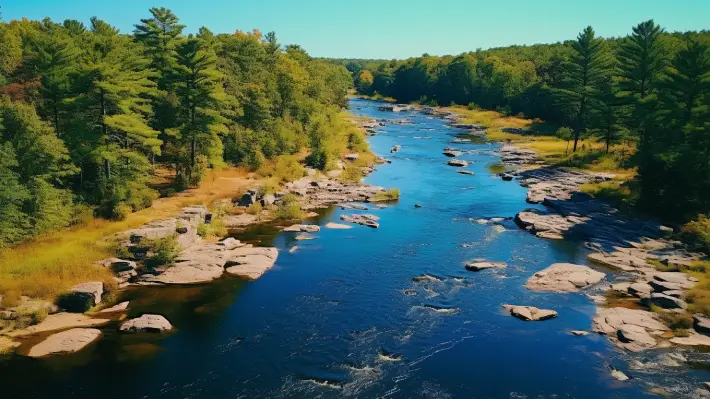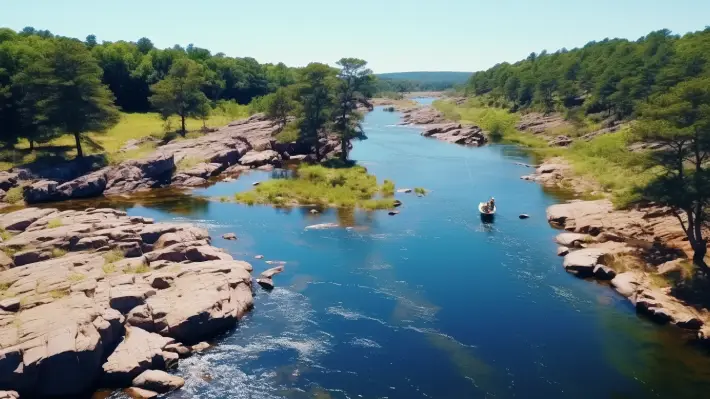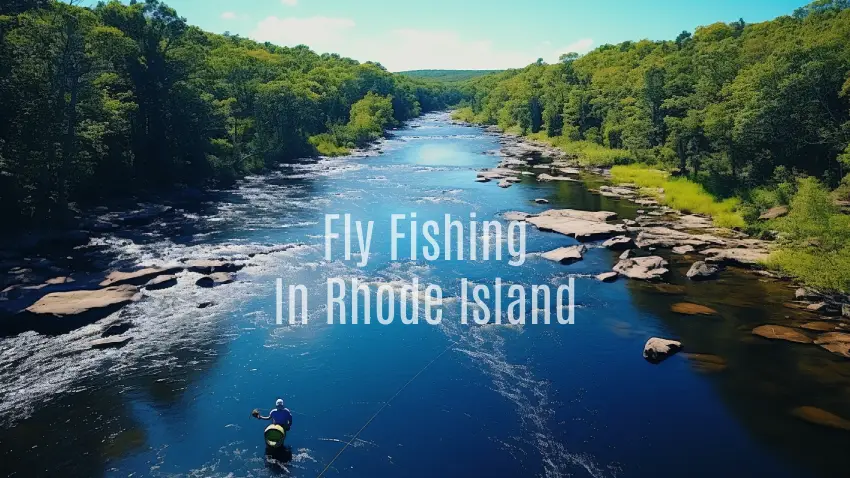Key Takeaways:
- Rhode Island offers diverse fly fishing locations like Wood River, Colt State Park, Blackstone River, and Quonochontaug Pond, catering to various angler preferences.
- The best time for fly fishing in Rhode Island changes by season, with spring, summer, and fall providing varied angling experiences. Fall is known for exciting blitzes.
- Rhode Island offers a wide range of fish species to target, including trout, bass, panfish, and native predators like chain pickerel and northern pike.
- Fly fishing regulations are managed by the Rhode Island Department of Environmental Management. Understanding license requirements, prohibited activities, seasonal rules, and saltwater/freshwater distinctions for responsible fishing is crucial.
- Regulations can change, so stay updated with the latest rules and requirements by visiting the Rhode Island Department of Environmental Management’s site.
List of Rhode Island’s Top 9 Fly Fishing Locations

Get to know the prime angling destinations with our list of Rhode Island’s top fly fishing locations, offering thrilling opportunities for anglers of all skill levels.
- Wood River
- Colt State Park
- Blackstone River
- Quonochontaug Pond
- Prudence Island
- Ninigret Pond
- Narrow River
- Pawcatuck River
- Providence River
Now, check out each fly fishing spot in detail so you can confidently plan your next angling adventure and make the most of your time on the water.
1. Wood River
- Nestled in the southwestern part of Rhode Island, in the vast 14,000-acre Arcadia Management Area.
- Renowned for its excellent water clarity, with opportunities to catch brook trout, brown trout, and rainbow trout.
- Conveniently accessible near the Mount Tom Trailhead, and the best fishing conditions are typically in the summer and fall months.
2. Colt State Park
- Located on Poppasquash Neck in the town of Bristol, Rhode Island, within Narragansett Bay.
- Offers opportunities for saltwater fly fishing, primarily targeting striped bass.
- Late summer is the best time to fish here. Recommended flies include Clouser Minnows and Deceivers.
3. Blackstone River
- Flows through Massachusetts and Rhode Island, approximately 48 miles long.
- A formerly restored trout stream with rainbow and brown trout.
- Best to target in early spring and late fall, with recommended fly selections including Pheasant Tail Nymph and Hex Nymphs.
4. Quonochontaug Pond
- Coastal lagoons in Charlestown and Westerly, Rhode Island, are classified as ocean backwaters.
- Ideal for fly fishing for stripers and bluefish from a small boat, with tides playing a crucial role.
- Recommended flies include Deceivers, Clouser Minnows, shrimp, and crab patterns. Fishing activity increases with the tide.
5. Prudence Island
- Located in Narragansett Bay and is part of the town of Portsmouth, Rhode Island.
- Ideal for boat-based saltwater fly fishing, home to bluefish and stripers.
- A 10-weight rod with a wire leader is recommended. The island offers constant surface feeding by the fish.
6. Ninigret Pond
- A saltwater pond located in Charlestown, Rhode Island.
- Offers opportunities for stripers and bluefish, valuable for learning about saltwater fishing, fish movements, and tide understanding.
- Fly fishing gear recommendations cater to both freshwater and saltwater conditions, providing a versatile experience for anglers.
7. Narrow River
- A tidal river flowing from Narragansett Bay to the Atlantic Ocean.
- Home to striped bass, bluefish, flounder, and trout.
- Spring and fall are the best times to fish in Narrow River, offering diverse fish species.
8. Pawcatuck River
- Flows approximately 34 miles (55 km), meandering along the border of Rhode Island and Connecticut.
- A preferred spot for experienced fly fishermen. Home to trout, bass, and shad, with scenic beauty and challenging fishing conditions.
- Best fishing seasons are summer and fall, suitable for both trout and warm-water fish species.
9. Providence River
- A tidal river in Rhode Island, flows approximately 8 miles (13 km).
- Ideal for catching striped bass during the winter, providing urban fishing opportunities.
- Great for urban anglers seeking a city environment, offers a unique contrast to the state’s more natural and remote fly fishing spots.
When is the ideal time for fly fishing in Rhode Island?

Rhode Island’s ideal fly fishing time varies with the seasons, offering diverse angling experiences throughout the year. In spring (March to May), you’ll find fantastic opportunities for pickerel, panfish, carp, pike, and trout.
As the ice thaws, these species become more active, and you can explore the Blackstone River and various ponds for a mix of trout, panfish, and carp.
In summer (June to August), though fishing can be slower, you can still target schoolie stripers, mackerel, and enjoy opportunities for bass, especially in areas with topwater action.
Fall (September to November) is the most exhilarating time for fishing in Rhode Island. During this season, you can witness the blitzes of little tunny, bonito, stripers, and sometimes large bluefish along the oceanfront.
It’s a wild time to be on the water and land some impressive catches. Each season offers its own unique charms and angling prospects, making Rhode Island a year-round fly fishing destination.
What fish species can you target while fly fishing in Rhode Island?
When fly fishing in Rhode Island, you’ll have the exciting opportunity to target diverse fish species. These include brook trout, brown trout, and rainbow trout, which are found in various rivers and streams like the Wood River and Blackstone River.
Largemouth and smallmouth bass are prevalent in Rhode Island’s lakes and ponds, with productive spots near Upper Narragansett Bay and the Sakonnet River. Additionally, you can try to land panfish such as bluegills, perch, and crappies, particularly during the early spring.
For those looking for a unique challenge, native freshwater predators like chain pickerel can be pursued in the state’s blackwater ponds. Furthermore, you’ll find the elusive northern pike in some weedy, shallow ponds.
What are the fly fishing regulations in Rhode Island?
Rhode Island’s Department of Environmental Management oversees fly fishing regulations. The regulations are in place to make fly fishing in the state’s waters responsible and sustainable.
Fishing Licenses: To engage in freshwater fly fishing in Rhode Island, you must obtain a fishing license if you’re aged 15 or above. The types of licenses and associated fees may vary based on your residency status, age, and other factors.
Free Fishing Days: Rhode Island offers Free Fishing Days on May 6th and 7th, 2023, during which residents and non-residents are not required to have a fishing license or a Trout Conservation Stamp.
Prohibited Activities: The state’s freshwater fishing regulations strictly prohibit a range of activities. Those include fishing without a license, fishing in closed streams or ponds, possessing trout, salmon, or charr during the seasonal closure, and using corn for bait.
Other prohibitions involve chumming in designated trout waters, snagging fish, using injurious substances in streams or freshwater ponds, and selling freshwater fish.
Seasons, Creel Limits, and Minimum Size Limits: Seasonal regulations vary depending on the species. Trout, for instance, can be caught from April 8th to November 30th with a daily creel limit of five fish during this period, and two fish from December 1st to the last day of February.
The minimum size for all trout and charr species is 8 inches. Different regulations apply to other species, such as Northern Pike, Chain Pickerel, Largemouth and Smallmouth Bass, American Eel, Striped Bass, and more.
Saltwater/Freshwater Boundaries: The regulations also address the distinctions between saltwater and freshwater fishing. They mention that a Trout Conservation Stamp is required to possess trout, salmon, or charr caught in Rhode Island waters or to fish in specific areas designated as ‘catch & release’ or ‘fly fishing only’ areas.
These boundaries help manage and conserve the diverse aquatic ecosystems in Rhode Island.
Always ensure that you are aware of and adhere to the latest regulations to enjoy a responsible and enjoyable fishing experience.To stay updated on any changes to these fly fishing regulations in Rhode Island, it’s advisable to visit the official website of the Rhode Island Department of Environmental Management.

